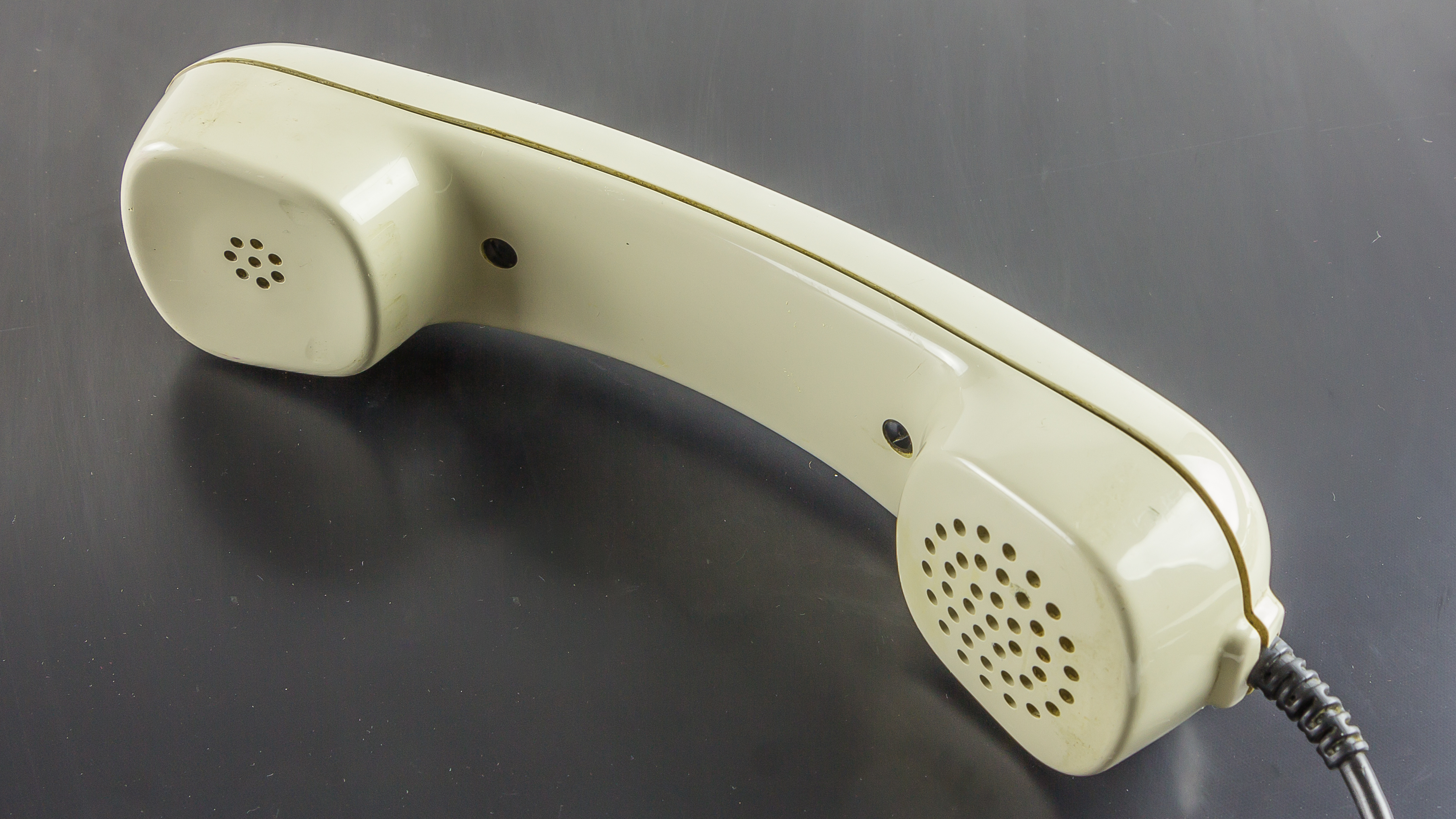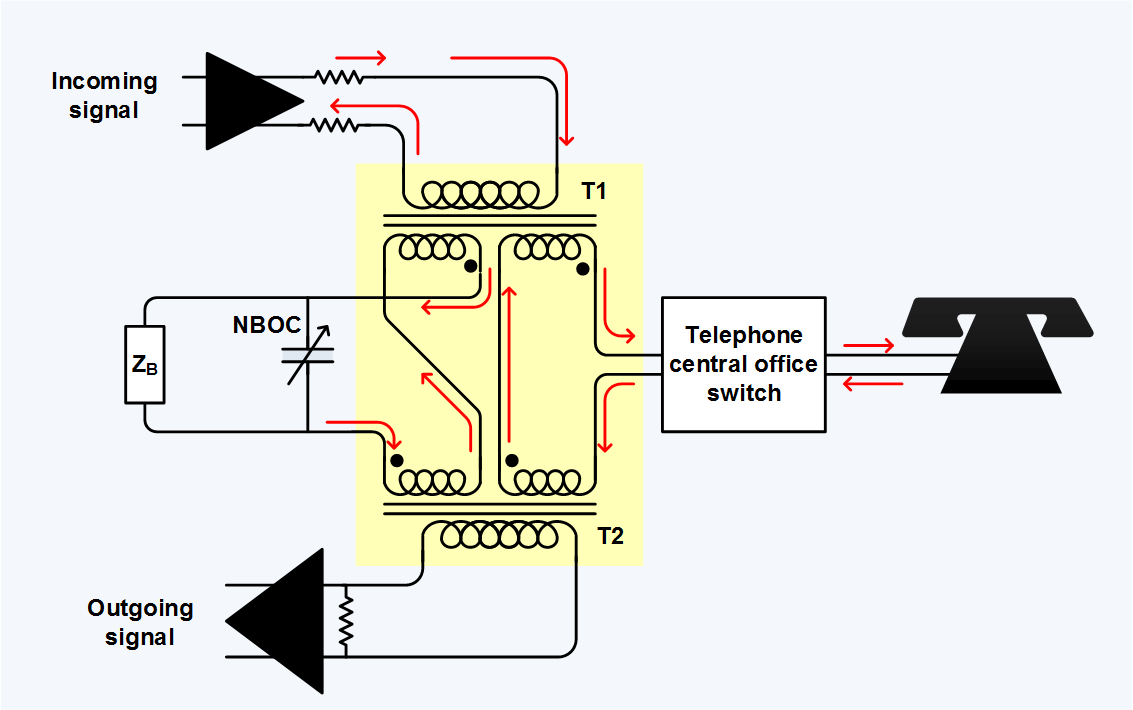|
Hybrid Coil
A hybrid coil (or bridge transformer, or sometimes hybrid) is a transformer that has three windings, and which is designed to be configured as a circuit having four ports that are conjugate in pairs. A signal arriving at one port is divided equally between the two adjacent ports but does not appear at the opposite port. In the schematic diagram, the signal into W splits between X and Z, and no signal passes to Y. Similarly, signals into X split to W and Y with none to Z, etc. Correct operation requires matched characteristic impedance at all four ports. Hybrids are a class of directional coupler in which the input port power is split equally between the two output ports. Forms of hybrid other than transformer coils are possible; any format of directional coupler can be designed to be a hybrid. These formats include transmission lines and waveguides. Explanation The primary use of a voiceband hybrid coil is to convert between 2-wire and 4-wire operation in sequenti ... [...More Info...] [...Related Items...] OR: [Wikipedia] [Google] [Baidu] |
Ground (electricity)
In electrical engineering, ground or earth is a reference point in an electrical circuit from which voltages are measured, a common return path for electric current, or a direct physical connection to the Earth. Electrical circuits may be connected to ground for several reasons. Exposed conductive parts of electrical equipment are connected to ground, to protect users from electrical shock hazard. If internal insulation fails, dangerous voltages may appear on the exposed conductive parts. Connecting exposed parts to ground will allow circuit breakers (or RCDs) to interrupt power supply in the event of a fault. In electric power distribution systems, a protective earth (PE) conductor is an essential part of the safety provided by the earthing system. Connection to ground also limits the build-up of static electricity when handling flammable products or electrostatic-sensitive devices. In some telegraph and power transmission circuits, the ground itself can be used as one co ... [...More Info...] [...Related Items...] OR: [Wikipedia] [Google] [Baidu] |
Sidetone
Sidetone is audible feedback to someone speaking or otherwise producing sound as an indication of active transmission. Sidetone is introduced by some communications circuits and anti-sidetone circuitry is used to control its level. Sidetone is expected behavior for telephone systems. Absence of sidetone can cause users to believe the call has been dropped or cause them to speak loudly. Too much sidetone can cause users to speak softly. Telephony In telephony, sidetone is the effect of sound picked up by the telephone's transmitter (mouthpiece) and instantly introduced at a low electronic signal level into the receiver (earpiece) of the same handset, a form of electrical feedback through the telephone hybrid.AT&T, ''Bell System Practices'', Section C30.001 Issue 1 (March 16, 1932) ''Common Battery Anti-Sidetone Stations'' Sidetone in early 19th century telephones was strong due to the type of circuit used in instruments. Anti-sidetone circuitry in the telephone hybrid brought sideto ... [...More Info...] [...Related Items...] OR: [Wikipedia] [Google] [Baidu] |
Carbon Microphone
The carbon microphone, also known as carbon button microphone, button microphone, or carbon transmitter, is a type of microphone, a transducer that converts sound to an electrical audio signal. It consists of two metal plates separated by granules of carbon. One plate is very thin and faces toward the speaking person, acting as a diaphragm (acoustics), diaphragm. Sound waves striking the diaphragm cause it to vibrate, exerting a varying pressure on the granules, which in turn changes the electrical resistance between the plates. Higher pressure lowers the resistance as the granules are pushed closer together. A steady direct current is passed between the plates through the granules. The varying resistance results in a modulation of the current, creating a varying electric current that reproduces the varying pressure of the sound wave. In telephony, this undulating current is directly passed through the telephone wires to the telephone exchange, central office. In public addre ... [...More Info...] [...Related Items...] OR: [Wikipedia] [Google] [Baidu] |
Impedance Matching
In electronics, impedance matching is the practice of designing or adjusting the input impedance or output impedance of an electrical device for a desired value. Often, the desired value is selected to maximize power transfer or minimize signal reflection. For example, impedance matching typically is used to improve power transfer from a radio transmitter via the interconnecting transmission line to the antenna. Signals on a transmission line will be transmitted without reflections if the transmission line is terminated with a matching impedance. Techniques of impedance matching include transformers, adjustable networks of lumped resistance, capacitance and inductance, or properly proportioned transmission lines. Practical impedance-matching devices will generally provide best results over a specified frequency band. The concept of impedance matching is widespread in electrical engineering, but is relevant in other applications in which a form of energy, not necessa ... [...More Info...] [...Related Items...] OR: [Wikipedia] [Google] [Baidu] |
Step-up Transformer
A transformer is a passive component that transfers electrical energy from one electrical circuit to another circuit, or multiple circuits. A varying current in any coil of the transformer produces a varying magnetic flux in the transformer's core, which induces a varying electromotive force (EMF) across any other coils wound around the same core. Electrical energy can be transferred between separate coils without a metallic (conductive) connection between the two circuits. Faraday's law of induction, discovered in 1831, describes the induced voltage effect in any coil due to a changing magnetic flux encircled by the coil. Transformers are used to change AC voltage levels, such transformers being termed step-up or step-down type to increase or decrease voltage level, respectively. Transformers can also be used to provide galvanic isolation between circuits as well as to couple stages of signal-processing circuits. Since the invention of the first constant-potential transform ... [...More Info...] [...Related Items...] OR: [Wikipedia] [Google] [Baidu] |
Induction Coil
An induction coil or "spark coil" ( archaically known as an inductorium or Ruhmkorff coil after Heinrich Rühmkorff) is a type of electrical transformer used to produce high-voltage pulses from a low-voltage direct current (DC) supply. p.98 To create the flux changes necessary to induce voltage in the secondary coil, the direct current in the primary coil is repeatedly interrupted by a vibrating mechanical contact called an interrupter. Invented in 1836 by Nicholas Callan, with additional research by Charles Grafton Page and others, the induction coil was the first type of transformer. It was widely used in x-ray machines, spark-gap radio transmitters, arc lighting and quack medical electrotherapy devices from the 1880s to the 1920s. Today its only common use is as the ignition coils in internal combustion engines and in physics education to demonstrate induction. Construction and function An induction coil consists of two coils of insulated wire wound around a ... [...More Info...] [...Related Items...] OR: [Wikipedia] [Google] [Baidu] |
Handset
A handset is a component of a telephone that a user holds to the ear and mouth to receive audio through the receiver and speak to the remote party using the built-in transmitter. In earlier telephones, the transmitter was mounted directly on the telephone itself, which was attached to a wall at a convenient height or placed on a desk or table. Until the advent of the cordless telephone, the handset was usually wired to the base unit, typically by a flexible tinsel wire. The handset of a cordless telephone contains a radio transceiver which relays communication via a base station that is wired to the telephone line. A mobile phone does not require a base station and communicates directly with a cell site in designated frequency bands. Handset symbol A graphic symbol that designates a handset is used on cordless and mobile phones to specify placing or ending a telephone call. Usually a button with green upright (off-hook) handset icon is used for starting a call, and a red ... [...More Info...] [...Related Items...] OR: [Wikipedia] [Google] [Baidu] |
Telephone
A telephone is a telecommunications device that permits two or more users to conduct a conversation when they are too far apart to be easily heard directly. A telephone converts sound, typically and most efficiently the human voice, into electronic signals that are transmitted via cables and other communication channels to another telephone which reproduces the sound to the receiving user. The term is derived from el, τῆλε (''tēle'', ''far'') and φωνή (''phōnē'', ''voice''), together meaning ''distant voice''. A common short form of the term is ''phone'', which came into use early in the telephone's history. In 1876, Alexander Graham Bell was the first to be granted a United States patent for a device that produced clearly intelligible replication of the human voice at a second device. This instrument was further developed by many others, and became rapidly indispensable in business, government, and in households. The essential elements of a telephone are ... [...More Info...] [...Related Items...] OR: [Wikipedia] [Google] [Baidu] |
Last Mile (telecommunications)
The last mile or last kilometer is a phrase widely used in the telecommunications, cable television and internet industries to refer to the final leg of the telecommunications networks that deliver telecommunication services to retail end-users (customers). More specifically, the ''last mile'' describes the portion of the telecommunications network chain that physically reaches the end-user's premises. Examples are the copper wire subscriber lines connecting landline telephones to the local telephone exchange; coaxial cable service drops carrying cable television signals from utility poles to subscribers' homes, and cell towers linking local cell phones to the cellular network. The word "mile" is used metaphorically; the length of the last mile link may be more or less than a mile. Because the last mile of a network to the user is conversely the first mile from the user's premises to the outside world when the user is sending data, the term first mile is also alternatively ... [...More Info...] [...Related Items...] OR: [Wikipedia] [Google] [Baidu] |
Telephone Exchange
telephone exchange, telephone switch, or central office is a telecommunications system used in the public switched telephone network (PSTN) or in large enterprises. It interconnects telephone subscriber lines or virtual circuits of digital systems to establish telephone calls between subscribers. In historical perspective, telecommunication terms have been used with different semantics over time. The term ''telephone exchange'' is often used synonymously with ''central office'', a Bell System term. Often, a ''central office'' is defined as a building used to house the inside plant equipment of potentially several telephone exchanges, each serving a certain geographical area. Such an area has also been referred to as the exchange or exchange area. In North America, a central office location may also be identified as a ''wire center'', designating a facility to which a telephone is connected and obtains dial tone. For business and billing purposes, telecommunication carriers def ... [...More Info...] [...Related Items...] OR: [Wikipedia] [Google] [Baidu] |
Telephone Hybrid
A telephone hybrid is the component at the ends of a subscriber line of the public switched telephone network (PSTN) that converts between two-wire and four-wire forms of bidirectional audio paths. When used in broadcast facilities to enable the airing of telephone callers, the broadcast-quality telephone hybrid is known as a broadcast telephone hybrid or telephone balance unit. The need for hybrids comes from the nature of analog plain old telephone service (POTS) home or small business telephone lines, where the two audio directions are combined on a single two-wire pair. Within the telephone network, switching and transmission are almost always four-wire circuits with the two signals being separated. Hybrids perform the necessary conversion. In older analog networks, conversion to four-wire was required so that repeater amplifiers could be inserted in long-distance links. In today's digital systems, each speech direction must be processed and transported independently. The li ... [...More Info...] [...Related Items...] OR: [Wikipedia] [Google] [Baidu] |






.jpg)
